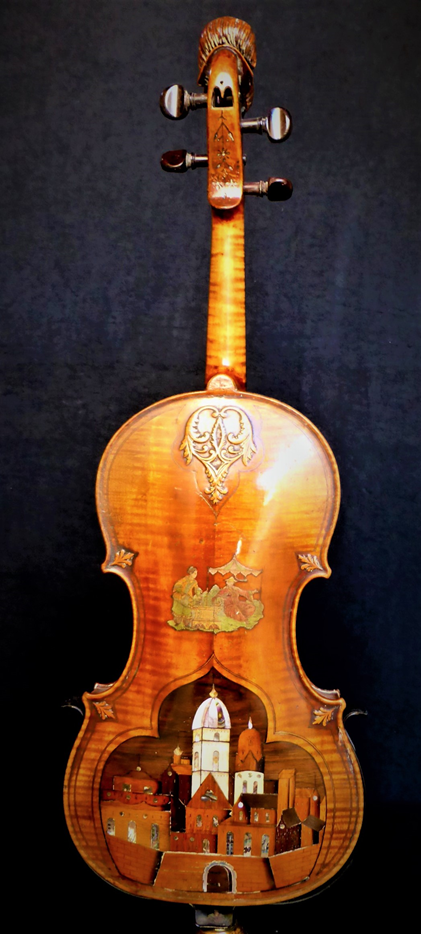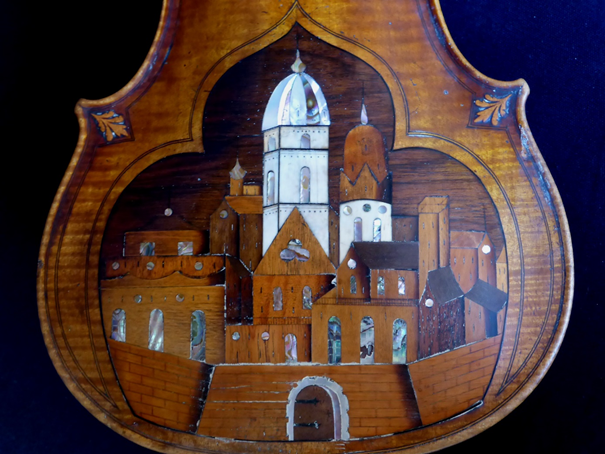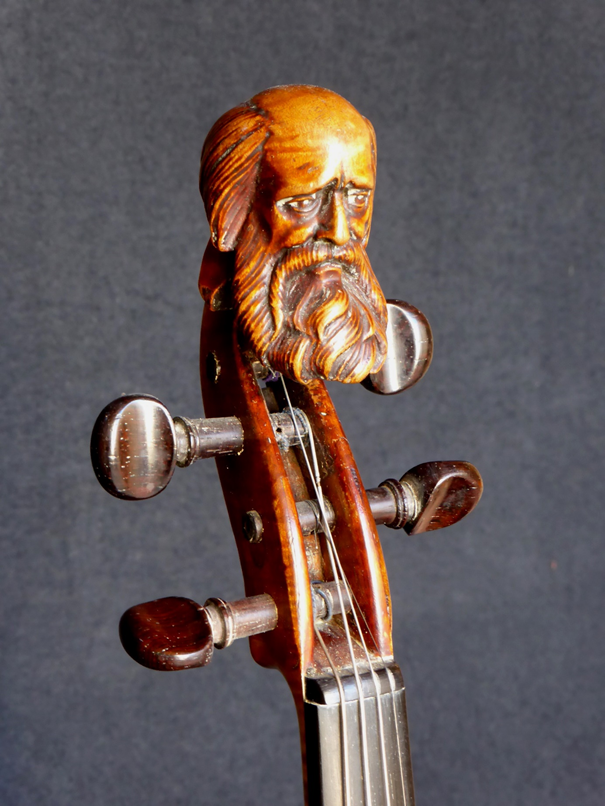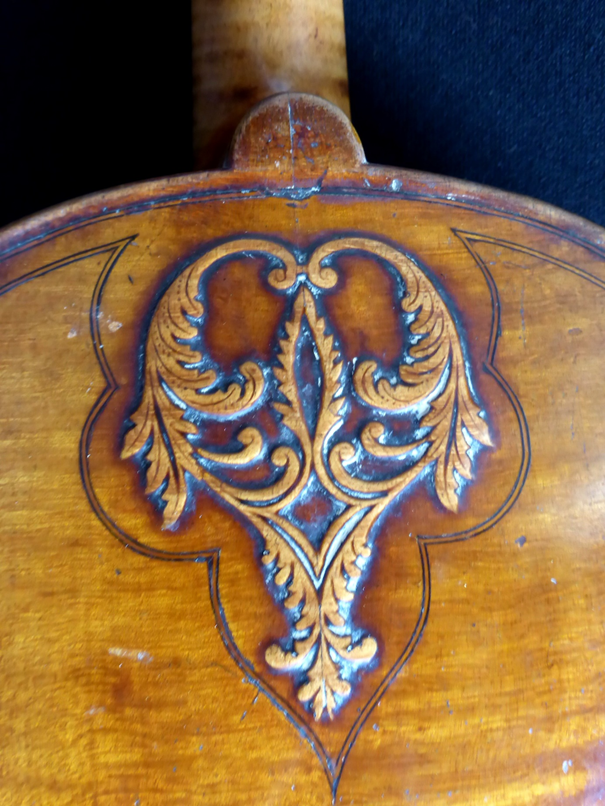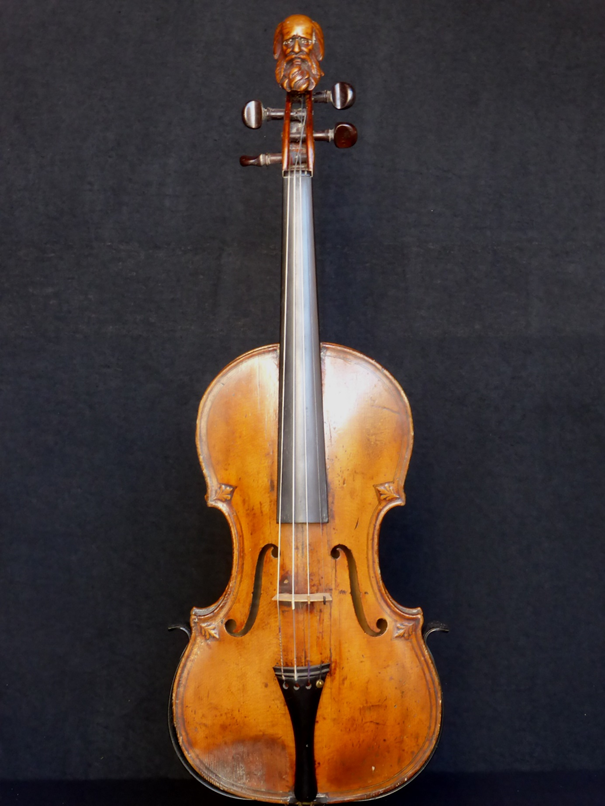VIOLIN “DUIFOPRUGGAR”
Attributed to Honoré DERAZEY, 1794-1883.
The back, in two parts of curly maple, is surrounded by a double fillet and carved in low relief with floral motifs arranged at the top and at the four corners. The lower part is decorated with a large marquetry of bone, mother-of-pearl and different essences, representing a view of Jerusalem, inspired by Renaissance engravings. (1)
A polychrome decal representing, in the “chinoiserie” style, the tea ceremony, adorns the central part. (2)
The sides, in maple with tight waves, are engraved with the Latin inscription: “Viva fui in silvis, dum mortua, dulce cano”. (3)
The spruce top is decorated with the same floral-patterned spandrels as well as a double binding.
The neck is inserted into the peg box. The latter is carved with the head of an old man, supposed to represent the luthier Gaspard Duiffopruggar. (4)
Body length: 36.2cm.
Jean Joseph DERAZEY did his apprenticeship in Mirecourt before working with Parisian luthiers. An excellent worker, around 1830 he became a precious collaborator of Jean-Baptiste Vuillaume who entrusted him with most of the manufacturing of “old instruments”. Inspired by the works of Gaspard Duiffopruggar and Gasparo da Salo, or rather imagined, the aesthetics of these violins above all illustrate the interpretation of the Renaissance style in the 19th century, if not its invention…
(1) We have not been able to find an engraving (a tapestry or a painting) that served directly as a model for these decorations. There is probably none given the different versions represented on the back of the instruments. In addition to the obviously orientalist form of the motif in which the marquetry is inscribed, several reasons lead us to consider that it is Jerusalem: The presence of minarets, the domes without crosses covering the buildings as well as their layout… Among other references, this representation of the Holy Sepulcher in the book “The holy peregrinations of Jerusalem and its surroundings”, by Bernhard von Breidenbach, which can be compared to the central part of the marquetry.
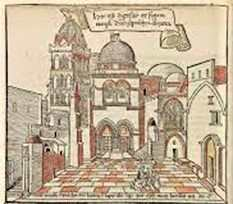 In “Des sanctes peregrinations de Jerusalem et ses environs”, translated into French by Nicolas Le Huin in 1488.
In “Des sanctes peregrinations de Jerusalem et ses environs”, translated into French by Nicolas Le Huin in 1488.
The success of Tasso’s “Jerusalem Liberated” at the end of the 16th century was such that the representation of the city became one of the reference figures in the iconography of the time and that the work gave (and will give) rise to many musical compositions, in particular Le combat de Tancred et Clorinde by Monteverdi, Armide, by Vivaldi, Lully or Glück, Rinaldo by Handel, etc.
Finally, it does not seem inappropriate to recall the place of Jerusalem and the Temple in the Masonic symbolism, because of the place of the lodges in the middle of the instrumental invoice in the XIXth century, in particular in Mirecourt.
(2) It appears that at the time the use of decals was widespread among luthiers, notably at Vuillaume. The present model, however, seems to have been fixed later.
(3) “I was alive in the forest, now dead, I sing softly”… Formula inspired by the one present on the engraving by Pierre Woieriot de Bouzey, published in 1562, representing “Gaspard Duiffoprougcar”. “Viva flu in Sylvis, sum dura occisa securi, Dum vixi tacui, mortua dulce cano”.
(4) Duiffopruggar, or Duyffoprugcar or even Tieffenbrucker, is the name of a famous dynasty of luthiers of German origin who worked in France and Italy. Gaspard, at the time considered by the French as a French luthier, then claimed by the Germans as a German luthier, while everyone agrees to attribute the invention of the violin to him, through a somewhat fanciful biography…
Works consulted:
– Roger MILLANT: J.B. Vuillaume, his life and work. W.E. Hill & sons, London 1972.
– René VANNES: Universal Dictionary of Luthiers. Friends of Music, Brussels 1979.
– Karel MOENS: Vuillaume and the first luthiers. Vuillaume exhibition catalog, City of Music, Paris 1999.
